Brescian School
Gasparo da Salo
(b. 1540
- d. 1609)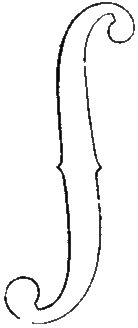
Originally a maker of viols and tenors, Gasparo da Salo's
violins
rose quickly to prominence, surpassing all his contemporaries,
and he soon became the head of the Brescian school.
Many of his instruments were made of pearwood and
sycamore,
especially his basses. The scroll particularly reflects the still
primitive state of the instrument.
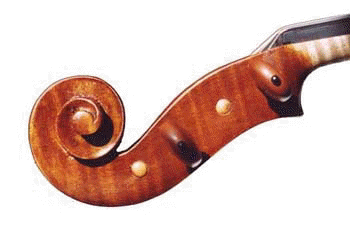
Gasparo da Salo is the name used by Gasparo Bertolotti (1542-1609), who was born at Salo on Lake Garda, Brescia, Italy. A dedicated craftsman, he was formerly credited with having developed the violin in the shape we now know it. Although this claim is now disproved, his instruments are nevertheless admired and venerated. He is considered to be the founder of the Brescian school of violin makers.
His violas are considered finer than his violins and were probably more numerous. His viola da gambas were converted to violoncellos and are much esteemed; and some six-stringed bass viols have been remounted as three-and four-stringed double basses. About twenty noteworthy instruments are recorded.
The body length of his violins is about 13 7/8"; violas, 16 5/16". The varnish is toast- or golden-brown with reddish tint and is magnificently transparent and elastic.
Giovanni Paolo Maggini (1580 - 1632)
Giovanni Paolo Maggini, born at Botticino near Brescia, Italy, apprenticed with the master violin maker Gasparo da Salo from age seven, where he remained until early adulthood. His patterns are rather large and broad in outline, but compact, with flattish arching sloping towards the purfling. His early work shows a strong Gasparo influence but is marked by rather crude workmanship. His instruments are sometimes ornamented by elegant curls of purfling, typically laid in a double line.
While acquiring a thorough knowledge of the various woods available to him, Maggini evolved his own style, and later, as a master, his own techniques of craftsmanship. He experimented frequently to improve the tone quality of his instruments and to perfect his construction methods; many of these improvements are still in use today. Maggini and Gasparo are considered the most important instrument makers of the Brescian school.
The instruments made by Maggini at the end of his career were his finest. They are known for the quality of the woods and unusually large f-holes (which are well curved and carefully finished), as well as for their exceptionally mellow tone. Many are ornamented on the back with such decorations as the St. Andrew's Cross, a clover-leaf device, tableaux, medallions, crests, or other motifs. Varnishes varied from a clear brown in his early efforts to a more brilliant transparent golden or reddish-brown color of rich quality in later instruments. The typical late-model Maggini has a double row of purfling and low sides.
Maggini is known to have made at least sixty violins, nine violas, two violoncellos, one double bass, and a few viols. His label appeared in the following forms:
Gio. Paolo Maggini in Brescia
Paolo Maggini in Brescia
Giovanni Paulo Megri
a Brescia, 1615

The Cremonese School
The Cremonese school was founded by Andreas Amati (1525 - 1611), who started out as a maker of rebecs and viols. Some authorities have suggested that Andreas started the manufacture of violins contemporaneously with Gasparo da Salo. Noted makers of the Amati school include Joseph Guarnerius, Francesco Ruggieri, Antonio Stradivari, Jean Battiste Grancino, Francisco Grancino, Andreas Guarnerius, and Sanctus Seraphino.
Nicolaus Amati (1596 - 1684)
Nicolaus, the grandson of Andreas Amati, was considered the greatest maker of this illustrious family. Numerous masters of the first part of the eighteenth century were his pupils. His most celebrated violins are those known as Grand Amati models. These were comparatively large instruments with long corners, bold scrolls and beautiful varnish, and although not powerful, werebrilliant in tone. Instruments made by Nicolaus Amati are also notable for their arching, which tends to be rather high at the center.
Antonio Stradivari (1644 - 1737)
Purported to have been a pupil of Nicolaus Amati, Antonio Stradivari is considered by many to be the greatest violin-maker that ever lived. Stradivari served his apprenticeship with Amati, and stayed until 1670. During this period, he is not thought to have signed his work. Independently wealthy as a young man, Stradivari was free to pursue his quest and passion for perfection. His work can be divided into three periods:
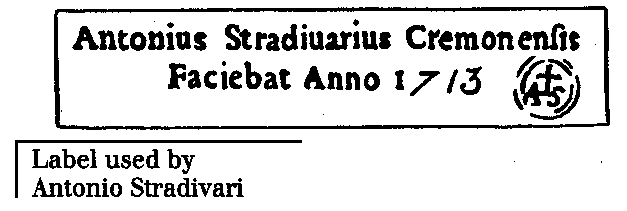
Circa 1668 - 1686
The instruments made during the first period are known as "Amatesé Stradivari", which resemble Amati's "Grand" model, but with modified corners, and flatter arching. The wood used during this period, although acoustically sound, tends to be less figured than his later instruments. It has also been said that Stradivari spent this time procuring what he thought to be the best wood.
Circa 1686 - 1694
The second period is characterized by graceful, larger
instruments with
even&endash;flatter arching, elegant f-holes, and 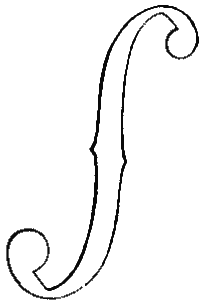 beautiful
golden or light red varnish. Towards the end of this period, Stradivari
made instruments known as "Long Pattern", so-monikered forthe
narrowness
between the f-holes, which gave the violins a lanky appearance.
beautiful
golden or light red varnish. Towards the end of this period, Stradivari
made instruments known as "Long Pattern", so-monikered forthe
narrowness
between the f-holes, which gave the violins a lanky appearance.
Circa 1695 - 1725
Deep and brilliant in tone, the best Stradivarius violins were made during the third period, when Stradivari was in his 50's. The grace, beauty, and faultless perfection of instruments made during this period reflect the greatest violin maker's powers at his peak, reaching its zenith around 1714. Supple and elastic, the glorious translucent varnish applied by Stradivari continues to baffle experts. Over the centuries, masterful copies perfect to the smallest detail, still fail to capture the soul that Strads from this era radiate. Only after 1725, does the work of this great master begin to show the effects of age.
Stradivari was a very prolific and industrious maker, completing, on the average, twenty five violins or ten celli a year. In his sixty or seventy years of activity, he must have completed well over a thousand instruments. A surprising number have survived to this day. However, as the single most imitated maker, there is little doubt that some of the surviving "genuine" Strads may ultimately be revealed as masterful copies.
Bartolomeo Giuseppe Guarneri (1698 - 1744)
Bartolomeo Giuseppe Guarneri (also known as Joseph Guarnerius del Gesu) was the greatest master of the celebrated Guarneri family of violin makers. He was the grandson of Andrea, and son of Giuseppe Giovanni Battista (who was known as Joseph Guarnerius filius Andreae). The term "del Gesu" comes from his labels which always incorporated the characters I.H.S. (Iesu Hominum Salvator) and a Roman cross.
Although his work may be divided into four periods,
instruments from
the third period exhibit great originality and superb varnish.
Instruments
of this period are broader in the waist, with long but elegant inner
bouts,
long and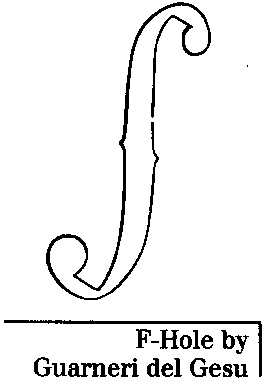 perpendicular f-holes, perfect scrolls and lovely varnish, said to
equal
Stradivari's. Deep and powerful in tone, Guarneri instruments are said
to rival those made by Stradivari.
perpendicular f-holes, perfect scrolls and lovely varnish, said to
equal
Stradivari's. Deep and powerful in tone, Guarneri instruments are said
to rival those made by Stradivari.
During the latter part of his life, many of Joseph del Gesu's instruments exhibited a noticeably impetuous and personal character. Contemporary research has dispelled the apocrophyl tales claiming that many of these instruments were "prison fiddles" or "drunken Josephs", made in prison, using wood, tools and varnish smuggled in by sympathetic jailers. On the contrary, these later instruments show remarkably accurate workmanship and originality. The famed violin virtuoso Nicolo Paganini's favorite violin was a Guarneri del Gesu violin from this era (1743).
Francesco Ruggieri (b.1620 - d.1695)
Thought to be Nicolo Amati's first pupil, Francesco Ruggieri is increasingly becoming recognized as a great Cremonese maker in his own right.
Although he left Amati's shop around 1641, Francesco Ruggieri continued to craft instruments in the Amati style, and often labeled them as such. Ruggieri also made a large number of celli, and experimented with the pattern, eventually developing a smaller, more manageable model than the typical large dimension standard of the 17th century.
Carlos Bergonzi (b.1683 - d.1747)
Bergonzi is one of the greatest Cremonese makers, overshadowed only by Antonio Stradivari and Giuseppe Guarneri del Gesu. Carlos Bergonzi is thought to have learned the art of violin making from Giuseppe Guarneri filius Andreae, and Guarneri del Gesu, and established his own shop around 1720.
Bergonzi's work is characterized by the delicacy of detail, especially his scrolls, which are cleanly carved and exceptionally symmetrical. His finest instruments date from 1730 to 1740, and are made from handsomely figured wood. Bergonzi apparently made neither violas nor celli.
Neapolitan School
Allessandro Gagliano (b. 1640 - d. 1725)
Allessandro was the first of this long-lived family of violin makers from the region of Napoli, whose members span almost two centuries.
Most of the Gagliano family made instruments based on the Stradivari model, except Allessandro. Best known for his fine celli, his instruments exhibit great character and originality, and even his varnish was distinctive; rich, limpid and deep red in color.
Nicola and Gennaro Gagliano, sons of Allesandro were fine craftsmen, greatly influenced by Stradivari, and Amati. The brothers also made celli based on the Stradivari model, and developed a narrower model which was subsequently adopted by a majority of Neapolitan makers.
Tyrolean School
Jacobus Stainer (b.1620 - d.1683)
The greatest maker of the German school of violin-making,
Jacobus Stainer
originally worked for Herz, the famous organ builder, before settling
on
the profession for  which
he is now famous. Few makers have been more abundantly copied.
which
he is now famous. Few makers have been more abundantly copied.
Said to have been a pupil of Nicolaus Amati, Stainer's violins were first offered for sale in the late 1630's. Pupils of note include Mattias Albani (1654), and members of the Klotz family (1670 - 1700).
Highly original, Stainer's instruments, although typically small in pattern, exhibit strong edges with purfling set rather near them, well-cut f-holes, and are far more highly arched than Cremonese instruments, especially between the upper bouts. The backs reflect more curvature than the bellies, with the summit of the arch almost as wide in dimension as the bridge. The scroll is often ornately finished with a carved lion's or animal's head, otherwise, they were left blunt and rather short.
Mattias Klotz (b.1656 - d.1743)
Considered by many to be the founder of the violin industry in
Mittenwald,
Germany, a statue of Mattias Klotz erected in 1890 can still be seen
there
to this day.
He received his first lessons from Jacobus Stainer, completing his education in Padua, Italy, under the aegis of Giovanni Railich, before returning to Mittenwald in 1678.
Although not always using the best woods, his work is excellent, and the tone of his instruments noteworthy. A good number of violins made by Mattias, and other members of the prolific Klotz family, are in existence.
French School
Nicholas Lupot (b.1784 - d.1824)
Considered the best of the French school, Nicholas Lupot has
been called
the "French Stradivari."
Pupil of his father, François Lupot, Nicholas came with him to Orleans when he was eleven. In 1794, Lupot went to Paris to work with François-Louis Pique, before finally opening his own shop in 1798. His pupils include Bernardel and Gand.
Reaching his zenith by 1810, Lupot copied Strad almost exclusively, but his copies of other great masters are also excellent.
Jean-Baptiste Vuillaume (b.1798 - d.1875)
Son and pupil of Claude Vuillaume V, Jean Baptiste Vuillaume
is said
to have been one of the most perfect imitators that ever lived.
Vuillaume
is also reputed to have been the only nineteenth century violin maker
who
was able to equal the varnish of the old Italians.
Enormously talented, he worked, at the age of nineteen, in the workshops of Lébé in Paris, and also with Francis Chanot. The influence of Lébé can be seen reflected in his work, and although he was taken in as a partner in 1825, Vuillaume left Lébé in 1828 to open his own shop.
Jean Baptiste Vuillaume was not only a meticulous maker, but as a dealer, handled many fine instruments, and was very successful at imitating other masters, especially Antonio Stradivari. Many instruments sold as genuine Stradivari, may in fact have been the work of Vuillaume. Vuillaume also engaged workmen to make bows and had pupils of his own as well. Out of his shop have come some of the most prominent French bow makers of the nineteenth century, including Eulry, Lenoble, Persois, Peccatte, and Voirin.